Antoine
Antoine Cierplikowski, also known as Monsieur Antoine or Antoine de Paris, was the world’s first celebrity hairdresser. A tireless self promotor, he captured the public’s attention with his novel hair creations and outlandish lifestyle.
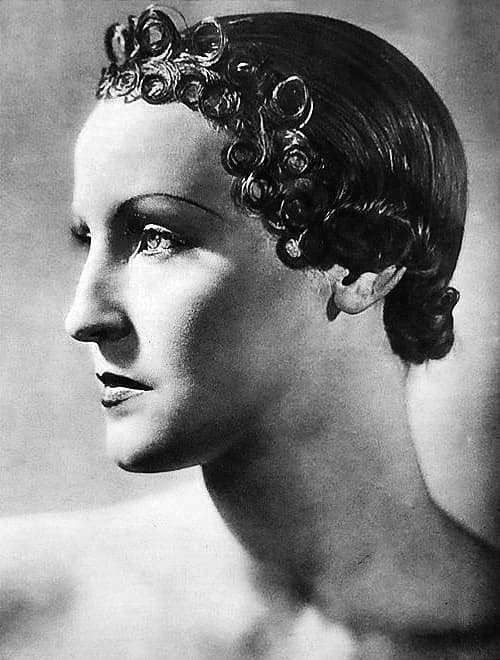
Above: 1932 Brigitte Helm, a.k.a. Brigitte Gisela Eva Schittenhelm [1906-1996], in an Antoine coiffure created for the German-French film ‘L’Atlantide’ (Nero-Film AG, 1932).
Antoine is also credited with a number of hairdressing innovations – the shingle cut, open plan salons, heated hair driers, hair lacquers, and the blue rinse.
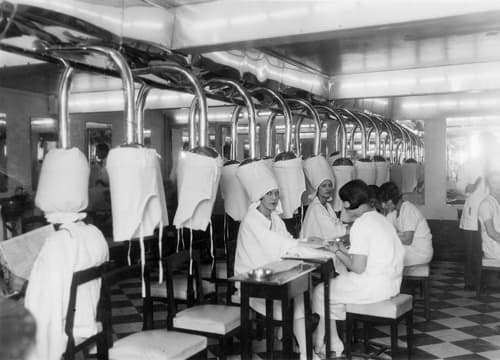
Above: c.1931 Women under metal hair dryers covered in white linen in salon at the Rue Cambon. Some being manicured while they wait.
Born in Sieradz, Poland, Antoine was introduced to hairdressing when he went to work in his uncle’s salon in Lodz. In 1901, he moved to Paris where, according to his autobiography, he got work waving postiches for Monsieur Paul Decoux in the basement below the Decoux salon on the Rue Lafayette. He then writes that he left Decoux to work for Maître Calloux. This refers to Maison Calou, a hairdressing establishment that operated in Paris and elsewhere from the late nineteenth century.
It was at Calou that Antoine says he met Berthe Astier who was employed there as a manicurist. He followed her to London and, when Berthe got pregnant, married her in 1909. Unfortunately, the child died and the couple decided to return to Paris where they rented a flat at 25 Rue Rodier, Montmartre and installed a phone so that Antoine could take bookings for work. Two years later they opened the salon at 5 Rue Cambon.
Despite his overt homosexuality, Antoine and Berthe remained married with Berthe managing Antoine’s growing business empire, something Antoine readily acknowledged.
I don’t think I would ever have reached any safe place in my career without her French common sense and her gift of saving pennies at the right moment. She has been and is the brilliant business manager of all my enterprises.
(Antoine, 1946, p. 41)
Expansion
Most of hairdressing inovations I previously alluded to took place in the 1920s. The 1930s were Antoine’s years of expansion. The Antoine stand at the 1927 ‘Exposition Française des Arts de la Coiffure et de la Parfumerie’ (1927) proudly displayed the addresses of three Antoine salons – 36 Dover Street, London; 5 Rue Cambon, Paris; and Saks Fifth Avenue, New York. This list would grow into the hundreds during the 1930s, spread around the world as far away as Australia.
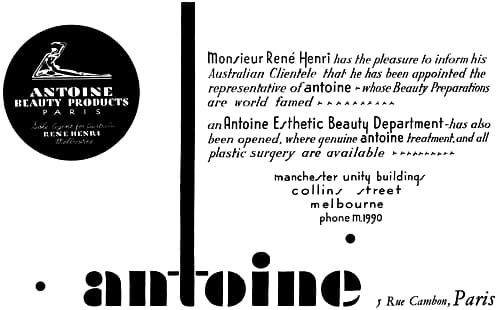
Above: 1934 Antoine (Australia).
Most of the hairdressing and beauty salons affiliated with Antoine operated under license, including those in Dover Street, Mayfair, and the Saks department store in New York. Antoine only personally invested in two salons in addition to the one at Rue Cambon. The first, in Rond-Point d’Armenonville, Cannes, was opened in 1930; the second, in the Place de la Bourse, Marseille, started in 1936.
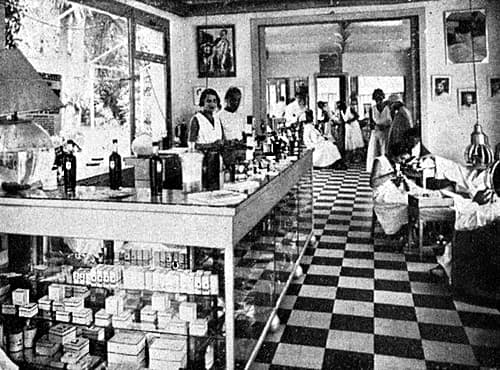
Above: 1932 Antoine salon in Cannes.
Britain
Antoine’s first overseas affiliation was in Britain. Antoine de Paris, Ltd. (capital £2,000) was established in London in 1925. A salon was opened at 38 Dover Street, Mayfair, situated above Alan McAffe, Ltd., and next door to the English branch of the Paris fashion designer Jeanne Paquin (1869-1936).
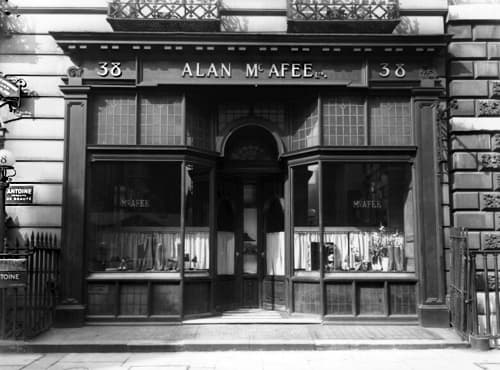
Above: 1938 Alan McAffe, Ltd. at 38 Dover Street, Mayfair, an exclusive English-made footwear company. The ‘Antoine Produits de Beauté’ and ‘Antoine Coiffures’ signs can just be seen on the left. The light globe on the stand, ornate canopy at the top of the stairs leading into the building, and much of the railings had gone by the 1970s.
United States
Antoine’s expansion into the United States began with Saks Fifth Avenue. In 1925, Horace Saks [1882-1925], of Saks Fifth Avenue, unexpectedly died from septicaemia and his assistant, Adam Gimbel [1893-1969], became the store’s new president. After taking over, Gimbel redecorated Saks in the new Art Deco style, added new specialty shops within the store, and invited Antoine to visit.
After receiving the invitation from Gimbel, Berthe was dispatched to New York in November, 1926, to negotiate the opening an Antoine salon in Saks. She returned to New York in February, 1927, to ensure that everything was ready for Antoine’s arrival in March. He returned for a second visit with Berthe in November and thereafter made regular trips to the United States.
The Antoine de Paris salon in Saks was operated by Seligman & Latz, a New York firm established by Sidney Seligman [1882-1962] and Edwin K. Latz [1886-1978] in 1911. They already operated the Georgian Beauty Salon at Saks but after Antoine was brought to the United States they negotiated the exclusive rights to operate Antoine salons across North America and changed the name of the Georgian Beauty Salon to Antoine de Paris.
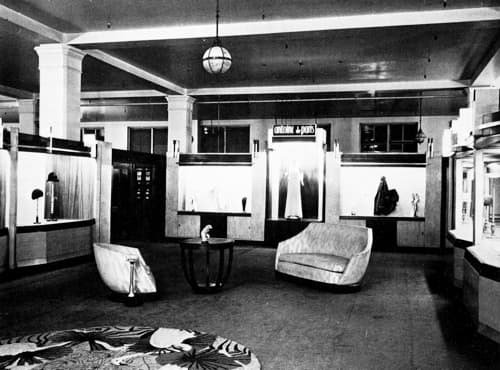
Above: c.1930 Antoine de Paris salon on the third floor of Saks.
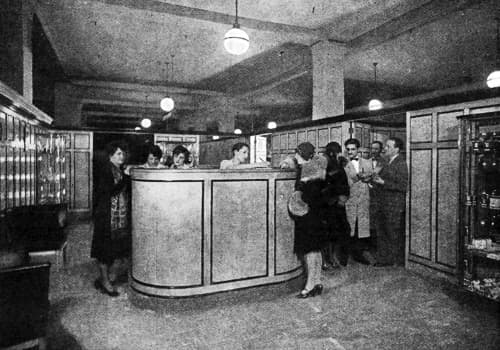
Above: 1927 Reception at the Antoine salon in Saks Fifth Avenue.
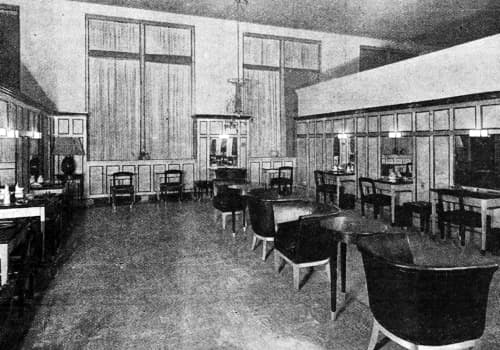
Above: 1927 Antoine salon in Saks Fifth Avenue.
In October, 1930, Berthe made her last trip to New York before the war travelling on the S.S. Ile de France. She was accompanied by Benoit Millien, so was presumably there to negotiate the introduction of Antoine cosmetics into North America.
Cosmetics
Exactly when Antoine began manufacturing cosmetics is unknown to me but it seems likely that commercial production started in France in 1925 or 1926. The symbol of a woman’s head used on a number of early Antoine cosmetics was trademarked in 1926 with Antoine adding a stylised figure of a woman in a gymnastic pose in 1932.
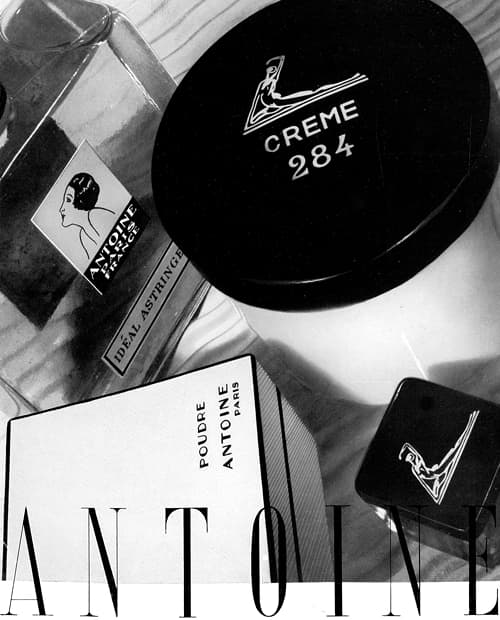
Above: 1934 Antoine cosmetics. Designs for the packaging have been credited to the multi-talented, Polish artist Sara Lipska [1882-1973].
French manufacturing took place at La Parfumerie de Gravigny at the Gravigny property that Antoine and Berthe bought around 1916, with the company opening offices in Paris at 6 Place de la Madeleine in 1928, subsequently moved to 4 Rue Saint-Didier by 1934.
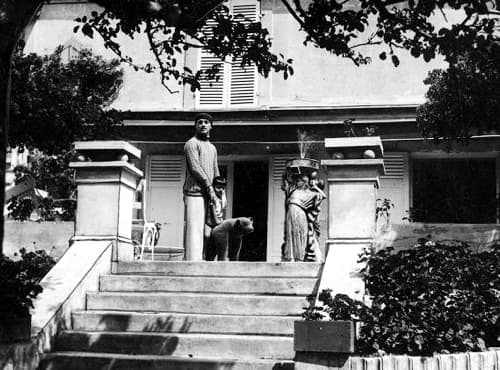
Above: This photograph of Antoine with an unknown small boy and a toy bear was reputedly taken in Gravigny.
The originator of the French formulations is also unknown to me. Antoine demonstrated his knowledge of makeup in an interview he gave to L’Art Vivant in January, 1925 (Charensol, 1925, p. 33) so it is hard to imagine that he did not play a part in their creation. It seems very likely that Berthe was also involved in the origin and ongoing development of the range.
Benoit Millien has also been credited with formulating the cosmetics. Some have described him as a chemist but I have been unable to confirm this. However, there is an interesting advertisement from Paris-Soir which, if it refers to Benoit, suggests he may have been engaged in manufacturing biscuits before he came to work at Gravigny. Baking and making cosmetics have many things in common.

Above: 1934 Advertisement in Paris-Soir.
Whatever his background, Benoit was heavily involved in the cosmetics side of the business. He was made the managing director of the Parfumerie de Gravigny, later becoming a company director, and he regularly travelled overseas to the United States and elsewhere on behalf of the firm.
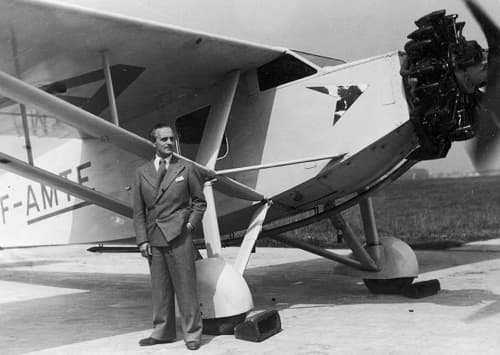
Above: 1937 Antoine standing in front of a Farman F391, one of two planes he acquired. Benoit took flying lessons, gained a pilot license, and used the planes to fly Antoine to various locations.
Hyman & Hyman
The American rights to Antoine cosmetics were sold to Hyman & Hyman, Inc., an established New York firm that had been manufacturing cosmetics, hair products and beauty shop equipment for decades. In 1931, Antoine de Paris, Inc. was established in New York (capital US$50,000) to import, manufacture and distribute Antoine cosmetics in North America with salons to open in select department stores.
The new Antoine Facial Salon, under the guidance of Antoine’s personal assistance (trained in his salon in Paris) is where beautiful eyes become more sparkling . . . a pretty mouth more tempting . . . and the entire face radiates a new charm (just a bit Parisian).
Antoine de Paris, Saks-Fifth Avenue advertisement, 1931)
The French and American cosmetic ranges differed in a number of respects. Edmond Marcel Fougera [1883-1954], the grandson of Charles Edmond Fougera [1821-1899], who founded E. Fougera & Co. in 1849, was hired by Hyman & Hyman to customise the Antoine range for the United States. So, although the American range had similarities with those produced by Produits Antoine in France, they were not identical. Fougera made some additions and left some French products out. For example, there is no mention of Idéal Astringent or Crème Astringent de Nettoyage in the American range.
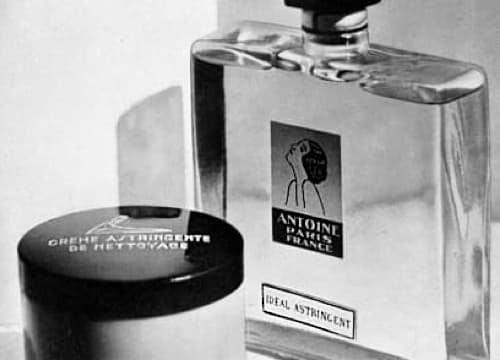
Above: 1934 Idéal Astringent and Crème Astringent de Nettoyage.
Antoine school
In 1933, to support the growing cosmetics range, the École Professionnelle Antoine was opened at 4 Rue Saint-Didier to train beauticians to use and sell the cosmetics. The school operated in purpose-built rooms which included a lecture studio and model salon.
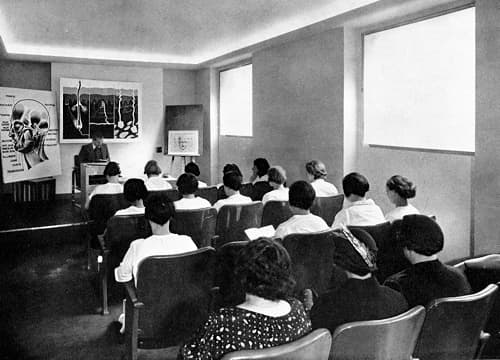
Above: 1933 Students in an anatomy lesson at the École Professionnelle Antoine.
Berthe was heavily involved in the development of the school and she personally delivered some of the program. Students were put through a two-month intensive course which included theoretical and practical subjects, receiving a diploma at the end of their studies.
American sale
Hyman & Hyman did not own Antoine de Paris for very long, selling out to the American Safety Razor Company in 1935. Sales of the Antoine range had been growing substantially in the United States so the reason for the disposal is unclear. However, changes at Hyman & Hyman may have played a part in the decision.
The president of Hyman & Hyman, Joseph Hyman [1886-1932], who had secured the rights to the Antoine line, died in 1932 and was succeeded as president by his older brother, Louis Hyman [1882-1948]. In 1934, Edmond Marcel Fougera was engaged again to develop a new cosmetic line for Hyman & Hyman which was named Farel Destin. Sold exclusively through beauty shops, Louis Hyman may have decided it was a better fit for the company than Antoine.
The new owners of Antoine de Paris, the American Safety Razor Company, had acquired Lightfoot-Schultz in 1930, a company founded by William Lightfoot Schultz [1876-1950] before he began Shulton. American Safety placed Antoine de Paris into ASR Products, a division of Lightfoot-Schultz.
After acquiring Antoine de Paris, American Safety Razor began an extensive advertising campaign for Antoine cosmetics which continued through the war. In 1939, they also moved the headquarters of Antoine de Paris into glamorous new offices at 663 Fifth Avenue.
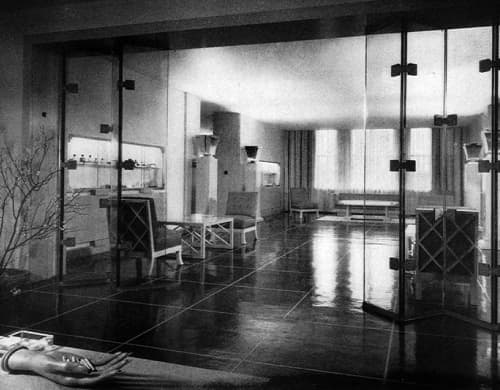
Above: 1940 Reception at the new offices of Antoine de Paris, Inc. at 663 Fifth Avenue, New York. A lot of glass was used, one of Antoine’s favourite materials.
War
When Paris fell to the Germans on June 14th, 1940, Antoine was not there. He had left for neutral Spain, boarded the luxury Italian liner the S.S. Rex in Lisbon and had arrived in New York on 6th January, 1940. He remained in America for the duration of the war, living either in his apartment at 930 Fifth Avenue – situated in a new building completed in 1940 – or in his house on Fire Island.
Berthe remained in Europe, presumably staying in her luxury apartment in the recently completed building on 1 Avenue Paul-Doumer and/or at the house in Gravigny. At some stage, the salon at 5 Rue Cambon was closed down but Antoine cosmetics remained available in France despite the war and the L’École de Beauté Antoine was still operating at 4 Rue Saint-Didier in 1944. I don’t have any information on the status of Antoine’s other salons in Cannes and Marseille.
After America entered the war in late 1941, Antoine de Paris, like many other companies, added a stocking substitute into its inventory. Introduced in 1942, Antoine Stocking Stand-In came in light and dark shades with medium added later. It got a very low report card from consumer groups as it was not water-resistant.
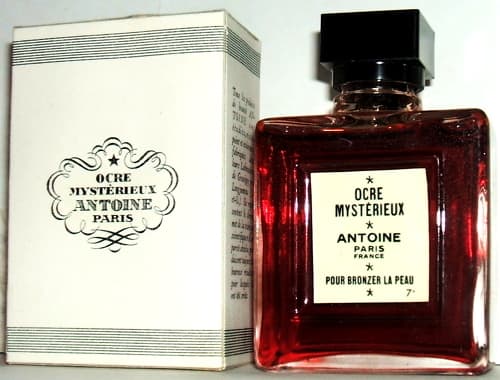
Above: Ocre Mystérieux.
The French company had a similar idea suggesting that an existing product, Ocre Mystérieux, could be used on the legs as a stocking replacement. It later developed Mirage, a liquid cream stocking replacement that could be used in sports or hiking in the countryside.
See also: Cosmetic Stockings
The Antoine salon at 38 Dover Street narrowly escaped being damaged when a German bomb fell on 40 Dover Street in 1940 and it remained open through the war into the 1960s.
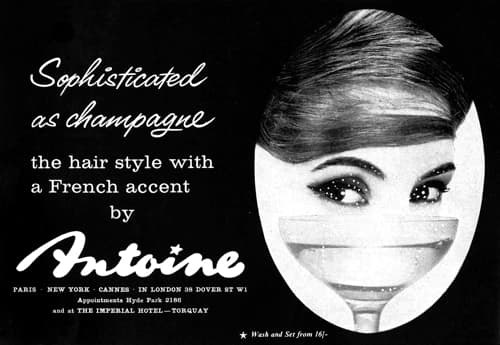
Above: 1960 Antoine salon 38 Dover Street, Mayfair.
Post-war
Antoine returned to Paris when it was safe to do so and reopened the salon at 5 Rue Cambon. Photographs from the 1950s indicate that its fittings and fixtures remained largely unchanged from the way it looked in the 1930s.
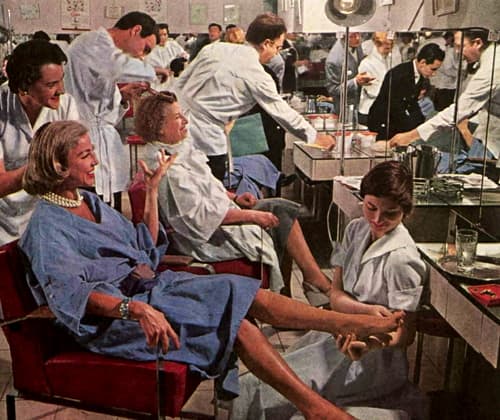
Above: 1956 Antoine salon at Rue Cambon, Paris.
Berthe and Benoit made trips to New York immediately after the war with Berthe making her last visit in September, 1946. She would eventually retire from the business bequeathing all of her interests to Benoit. I do not know when this happened but it may have been around the same time that Produits de Beauté Antoine S.A. was established in France in 1957. Antoine also got out of cosmetics around this time leaving the fortunes of Produits de Beauté Antoine in the hands of Benoit. It was deregistered in 1991 following Benoit’s death in 1990.
Antoine and Benoit continued to separately make regular trips to the United States in the 1950s, Benoit to deal with the cosmetics side of the business, Antoine to do tours promoting the Antoine de Paris salons operating across the United States. Antoine’s overseas trips were not restricted to the United States. The development of commercial airliners after the war made it easier to travel the world allowing Antoine to visit places as far away as Australia.
The American company, Antoine de Paris, went through a number of owners after the war becoming subsumed in ever larger organisations. Acquired by Parfums Lanvin in 1958 it then became part of Charles of the Ritz (1963), Squibb-Beechnut (1971), and Yves Saint Laurent (1986) before ending up in Revlon (1987). This appears to have been its final destination and, apart from Ban de Soleil, the range expired.
Products
Antoine cosmetics were sold in department stores in France and the United States but in many parts of the world they were only available through Antoine salons. This was certainly the case in London where the only outlet for Produits Antoine was Dover Street. The restriction may explain why most Antoine advertising was for the salons rather than the cosmetics. In France, a lot of pre-war product advertising and promotion was done through the ‘Antoine Document’, an in-house magazine produced in association with Parfumerie de Gravigny between 1932 and 1937.
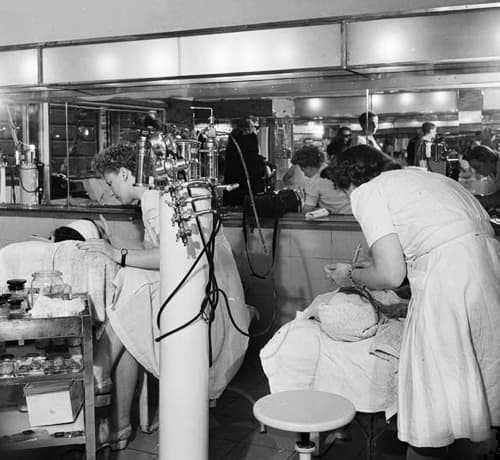
Above: 1932 Beauty treatments at 4 Rue Saint-Didier.
Skin-care
During the 1930s, the Antoine system of skin-care on both sides of the Atlantic followed the generally accepted ideas of the day. Prevention was considered to be better than cure, so morning and evening routines were recommended to help maintain the skin in good condition with adjustments made depending on whether the skin was oily or dry, robust or fragile.
Keeping the skin pores cleansed and closed was essential, so astringents were widely used in Antoine treatments. As well as being incorporated into a range of cosmetics, they were also added to liquids used in pulverisers/atomisers and to saturate pads in contour treatments that were held in place by chin straps.
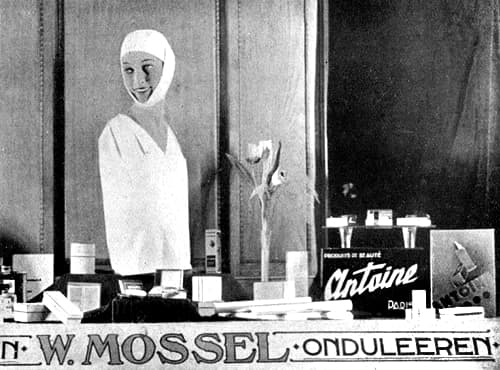
Above: 1933 Window display for Antoine products, including a chin strap, at Maison W. Mossel, Rotterdam.
See also: Straps, Bandages and Tapes and Vaporisers (Steamers & Atomisers)
Although not an ardent promotor of soap as a facial cleanser there were some instances where Antoine considered it useful, allowing him to do a product placement for Palmolive soap in the early 1930s.
The French Antoine skin-care routines in the 1930s were often simpler than those proposed for women in the United States. For example, in America the Antoine Quarter Hour, a fifteen-minute period of rest Antoine recommended before going out for dinner, involved four steps: 1. Cleansing, 2. Applying Antoine 50 (eye cream) around the eyes, 3. Massage with a massage cream, and then 4. Placing cotton pads saturated with Antoine 550 (eye lotion) over the eyes before resting. In France the routine was simply to cleanse the skin and apply compresses saturated with Lotion 550 over the eyes before putting your feet up for fifteen minutes.
Skin-care routines
Cleansing the skin, particularly at night, was vital, to remove dust and make-up and to clear the pores. In France, there was some variation in the recommended routine but typically it was suggested that Crème Astringente de Nettoyage was used at night to remove dirt and make-up followed by Idéal Astringent, diluted with rose or distilled water if the skin was delicate, to close the pores. Women with dry skin could then apply Crème Nourrissante to be left on overnight.
The more complicated American night routine followed cleansing with a massage routine using a heavy massage cream (Antoine 684) if the skin was dry or a lighter version (Antoine 685) if the skin was oily.
Cleansing and toning was repeated in the morning but finished with a day cream to be used as a powder base which varied according to skin type. Produits Antoine recommended Crème 284 for dry skin, Crème 285 for oily skin, and Crème 333 if the skin was normal. The last cream appears to have been a later addition introduced in France after the development of the American range. In the United States these three creams were labelled Antoine 284, Antoine 295, and Antoine 333 respectively.
Produits Antoine also included cosmetics for a number of general skin problems: Crème 22 combined with Idéal Astringent for blackheads and acne; and Crème 45 or Lotion 222 for seborrhoea and enlarged pores. All of these products were also available in America but given the usual Antoine designations.
See also: Antoine de Paris his Method (1932)
There were few changes to the French skin-care range in the years immediately after the war. The pre-war ideas of cleansing, toning, and nourishing were still followed but now used regimes that were closer to those used in the United States. The 1930s routine of cleansing with Crème Astringente de Nettoyage and toning with Idéal Astringent was altered after the war with allowances were made for skin types.
For skins that tended to be oily, the suggested French night treatment was now to cleanse with Crème de Nettoyage 425 then tone with Crème 425 diluted with a little Idéal Astringent. As in the 1930s, a nourishing cream was not used so that the skin could ‘breathe’ during sleep.
In the morning, the skin was wiped over with Préparation 740 then again toned with Crème 425 diluted with a little Idéal Astringent added in. Préparation 740 first appears in French advertising around 1941 and seems to have been adopted from the American range where it was primarily used as a make-up remover. This does not seem to be the only cosmetic the French range copied from the United States. Antoine Crème 10 also appears to have originally an American idea that was not available in France until the early 1950s. Essentially a bleach it lighten freckles and helped remove a tan.
For drier, more sensitive skins, the recommended French night treatment started with cleansing with Antoine 534, then toning with Lotion Antoine 760, followed by an application of Crème Nourrissante which was left on overnight.
In the morning, the skin was cleansed with Préparation 740 followed by a light coating of Crème Nourrissante which was left on for a few minutes then wiped off before make-up was applied.
In America, any reference to ‘nourishing’ was no longer possible after the passing of the 1938 Food, Drug & Cosmetic Act (FD&CA). After Antoine de Paris was sold to Lanvin in 1958 the new owners got around this problem by accentuating the moisturising properties of Antoine cosmetics. Many products were advertised as containing ‘Aqualite’ an unknown proprietary ingredient said ‘to help restore the moisture balance of the skin’. It was not trademarked and there is no mention of it in Antoine cosmetics sold in France.
Post-war treatments for problem skins on both sides of the Atlantic remained much as they were in the 1930s. Lotion 222 – now following the American notation and referred to as Antoine 222 – or Crème 45 (Antoine 45, USA) were still used for seborrhoea and enlarged pores, and Crème 22 (Antoine 22, USA) remained the recommended treatment for blackheads and acne.
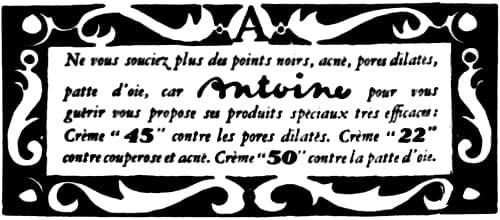
Above: 1950 Antoine Crème 45, Crème 22 and Crème 50.
Wrinkle treatments still relied on Crème 50 (Antoine 50, USA) around the eyes and the muscle oil, Huile Spéciale (Antoine 64, USA), but Produits Antoine now suggested Extrait Régénérateur to ‘instantly restore a fresh and smooth appearance to the epidermis’. Sold in ampules it was said to ‘invigorate cells, erase signs of fatigue and rejuvenate expression lines’.
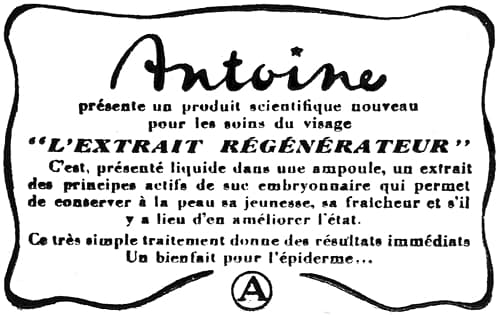
Above: 1953 Extrait Régénérateur. The recommended treatment was to use ten vials.
Extrait Régénérateur, which arrived on to the French market no later than 1949, was marketed as containing ‘embryonic juices’ but their source is unclear. At least one advertorial references Dr. Alexis Carrel [1873-1944] so it is possible that the juices were extracts from chicken embryos. However, the use of bovine amniotic fluid or placental extracts cannot be discounted.
Whatever its source, Extrait Régénérateur does not appear to have been introduced into North America. There, embryonic extracts did not arrive until Antoine de Paris introduced Creme Vitonia in 1959. Imported from France, in hand-decorated porcelain jars, it was formulated with embryonic fluids along with vitamins A, B, and E, a late response to American interest in ‘miracle biologicals’ during the 1950s.
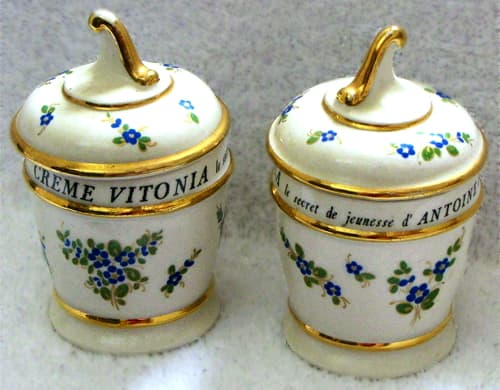
Above: Porcelain jars of Creme Vitonia.
See also: Embryo Extracts, Placental Creams and Serums and Royal Jelly
Crème Vitonia was sold in France earlier in the decade but I can find no evidence that it included embryo extracts or vitamins so the product may have been reformulated before being shipped to America.
Another ‘biological’ cosmetic added to the Produits Antoine range in France in the 1960s was Galbylène Serum. It contained placental extracts and was combined with Crème Vitonia in breast-firming treatments.
Masks
As far as I can tell, Produit Antoine’s first mask was not found in North America. It was made by adding an egg yolk to a teaspoon of Poudre Régénératrice. Antoine claims to have been adding embryo extract to cosmetics in the 1930s so perhaps powdered chicken embryo extract was the ‘regenerating’ ingredient included in Poudre Régénératrice. Powdered extract was commercially available in the 1930s so would have been easy for Produits Antoine to source.
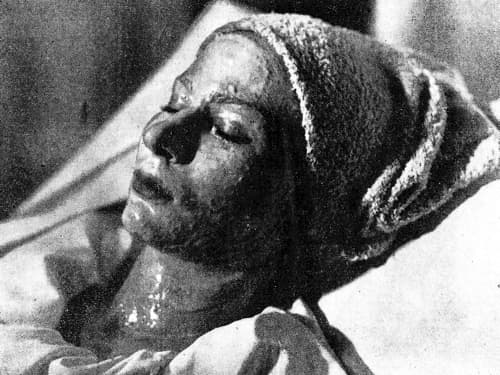
Above: 1936 Poudre Régénératrice mixed with egg yolk face mask.
Poudre Régénératrice was recommended as an evening treatment once or twice a week. It was left on the skin for twenty minutes before being removed with lukewarm water. This was followed with a massage with the previously mentioned Huile Spéciale (Antoine 64, USA) a muscle oil that was also used to restore muscles and combat wrinkles.
See also: Muscle oils
Antoine 40 (contour mask) was available in the United States in the 1930s but it was only used on dry skin and I have no evidence that an egg yolk was added to it.
Around 1949, the Antoine range debuted Masque 24 both in France and America. This creamy masque contained vitamins, hormones, and plant extracts which had astringent, softening and stimulating effects on the skin said to give the complexion an ‘exceptional glow’. As far as I can tell it was the only Antoine cosmetic formulated with hormones.
See also: Conseils d’Antoine (c.1949)
Suntanning
By the 1930s, suntanning had become highly fashionable. Produits Antoine’s recommended suntanning cosmetic was Bain de Soleil, a tinted cream that gave the skin a smooth, coppery complexion and helped develop a tan.
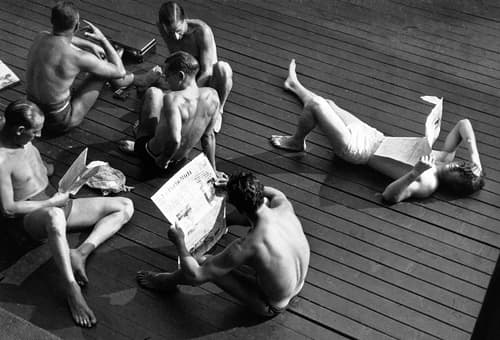
Above: 1934 Men suntanning on the deck of the Deligny Floating Pool that was once moored on the River Seine in Paris. It sank in 1993.
The original Bain de Soleil did not contain a sunscreen. Berthe claimed that it would help avoid the blistering associated with sunburn because it was ‘not a thick oil’ so did not ‘dilate the pores’, something she considered to be a major cause of blistering after sun exposure.
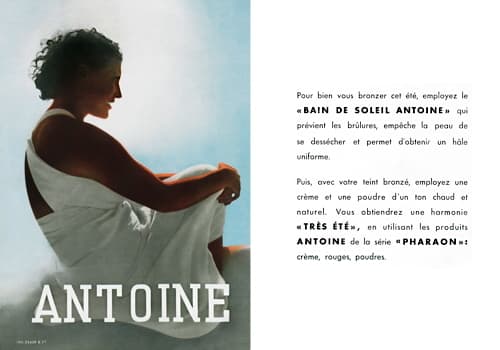
Above: 1934 Antoine Bain de Soleil.
A second suntanning preparation introduced into the French Antoine range after 1936 was Huile à Bronzer, a standard tanning oil. Like Bain de Soleil, it could also be used on the ski slopes.
Those who wanted an instant tan could apply the previously mentioned Ocre Mystérieux. Available by 1930 at the latest, it may have contained an astringent as it was also said to ‘firm the skin’ as well as darken it.
When Berthe visited New York in 1946, she announced that Produits Antoine had created a new oil foundation designed to reveal the transparency of the skin while highlighting its colour tone. She may have been referring to Coup de Vent, an amber-coloured liquid, named after Antoine’s villa in Cannes. It came in two formulations: one for dry or delicate skins, the other for more resistant or oily skins. Like Ocre Mystérieux it could be used to give the skin a light, artificial tan and was recommended as a skin protectant for sportswomen.
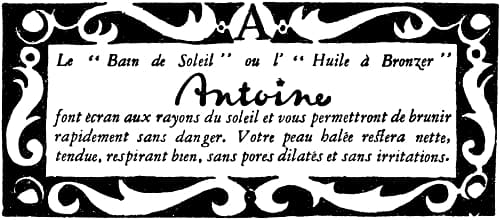
Above: 1950 Antoine Bain de Soleil and Huile à Bronzer.
Bain de Soleil continued to gain popularity in the America and when Charles of the Ritz owned the brand they made it the second-biggest tanning brand in the United States. Charles of the Ritz developed versions with Sun Protection Factors (SPFs) and created other lines specifically formulated for the face. Charles of the Ritz was sold to Revlon in 1987 but Revlon quickly on sold the Bain de Soleil brand to Richardson-Vicks, a subsidiary of Procter & Gamble. The new owners extended the range to over 20 products before selling it to Pfizer in 1995. When it was discontinued in 2019 it was owned by Schering-Plough who bought the line in 1999.
Ski cosmetics
By 1936, Produits Antoine had developed a range of cosmetics for the ski slopes. Antoine was a keen ice skater so probably tested some of the cosmetics on himself. Recommended preparations included Antoine Creme Pour le Ski, called Ski-Cream in the United States, which helped avoid chapping and redness in cold, dry air but was also recommended as a powder base; Ski Lipstick to proof the lips against wind, cold and moisture loss; and Lotion 880, developed earlier as a hand and foot protectant but also recommended for use in cold conditions.
Both in France and in the United States, Ski Cream became increasingly advertised as an all-purpose cream and powder base. This followed a European tradition where ‘sports creams’ were recommended as all-purpose.
See also: All-Purpose Creams
When Charles of the Ritz took possession of the line they continued to market Ski-Cream as an all-purpose cream and it became one of the most important cosmetics in their Antoine range, second only to Ban de Soleil.
Make-up
The make-up range introduced by Produits Antoine covered all the main bases – foundations, face powders, liquid powders, cream and compact rouges, lipsticks, mascara, eye-shadows and eyebrow pencils.
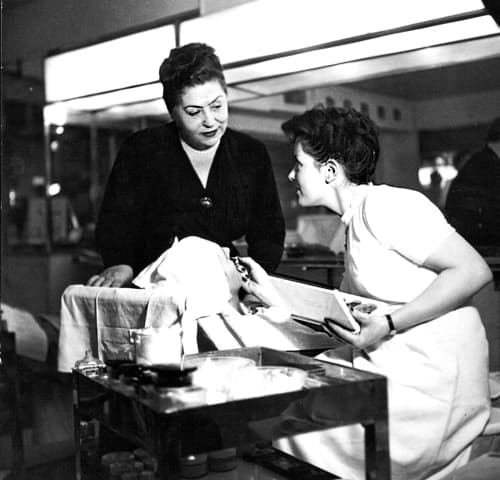
Above: Berthe observing a make-up procedure at Rue Saint-Didier.
Powders and foundations
The previously mentioned day creams could be used as a base for powder but, by 1937, Produits Antoine had introduced tinted foundations (fonds de teint). As well as being coloured, they had a thicker consistency than the day creams so were more covering. Shades included Pharaon, Triomphe, Glorieux, and Soleil.
Powder applied over a day dream or a foundation came in a limited range of shades but included tints that were suited to a wide variety of skin tones from white to tanned. In France before the war these included Ivoire, Ocrée, Ocre Rosée, Ocre Transparente, Ambre Doré, Pharaon 1, Pharaon 2, Tahiti, Messidor, Candeur, Grand Soleil, and Esterel.
The American range had separate powder formulations for Normal, Dry and Oily skin types, something I have not seen replicated in the French range. When first introduced these came in Ivoire, Rachel, Ochre-Rouge, Pharaon, Transparent, Peche Petal, and Rose shades. The American Antoine de Paris also provided clients with a powder blending service, similar to that introduced by Charles of the Ritz. These operated in some of the larger department stores from the early 1930s and appear to be endemic to America.
If you’re looking for something new, let Antoine de Paris mix you a special shade of powder to match your complexion.
(Strawbridge & Clothier advertisement for Antoine, 1935)
Produits Antoine also sold Blanc Mystérieux, a typical liquid powder that could be used in the evening to whiten arms and the décolletage. It was available in France by 1930 along with the previously mentioned Ocre Mystérieux. The American range also had a liquid powder, Antoine 185, which came in three shades – Ivoire, Peche Petal, and Pharaon.
Also see: Liquid Face Powders
Produits Antoine reformulated its face powders immediately following the war and also updated their shade ranges. Powder shades from Produits Antoine available through to 1960 included: Aurore, Ocre, Ocre Rose, Candeur, Ocre Transparent, Messidor, Ambre Doré, and Pharaon. As before, it was expected that face powder was applied over a day cream such as Crème Antoine 333, 284 or 285 or a fond de teint (foundation) which came in shades including Candeur, Hardi, Eboulissant, Bengali, Pharaon, and Talisman.
Different powder shades were recommended for daytime and evening and it was also suggested that they were used in combination – a lighter tone on the forehead and a harmonised darker tone on the cheeks – but only if the powders were applied over a colourless powder base such as a day cream. This was in contrast to Elizabeth Arden who recommended applying two shades of powder over the entire surface of the face.
Also see the Arden booklet: Why two powders are better than one (.c.1944)
In 1950 or 1951, Produits Antoine introduced Satin Pêche, a liquid powder cream. It was applied with the fingers to skin that had been previously cleansed and toned. It produced a luminous matt finish and came in four shades – Hardi, Talisman, Pharaon, and Rose-Émoi. It was recommended for the face, shoulders, neck, and décolletage but could also be used on the hands.
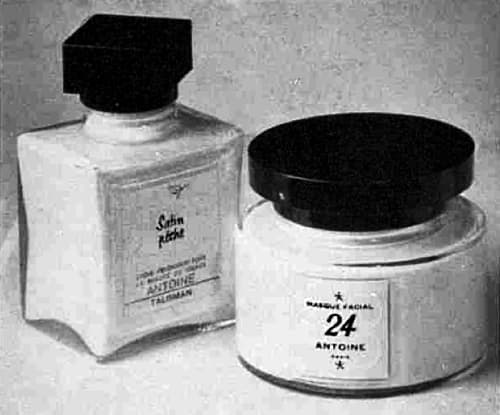
Above: 1955 Antoine Satin Pêche and Masque 24 (UK).
Satin Peche was available in the United States by 1954 where it was described as a fluid-cream foundation suitable for the face, neck and shoulders. It came in the same bottle and the same four shades as the French product – Hardi, a rosy mother-of-pearl tone; Talisman, a rich apricot shade; Pharaon, a pinkish hue for suntanned skins; and Rose-Émoi, a light and unsophisticated make-up – which suggests it was fully imported. In 1959, it appears to have been superseded in the United States by Mistone Fluid Make-up formulated with the previously mentioned Aqualite.
Later in the decade, Produits Antoine followed Satin Pêche with Doux Pastel, a tinted powder cream that functioned as a skin protective and make-up base. It was sold in a white, opaline compact with mirror and puff. Although it could be applied under powder, its matt finish meant that it could be used alone although two coats were then recommended. Like Satin Pêche it came in a limited range of shades – Talisman, Pharaon, Rose-Émoi, Sirocco, and Exotique.
Lipstick and rouge
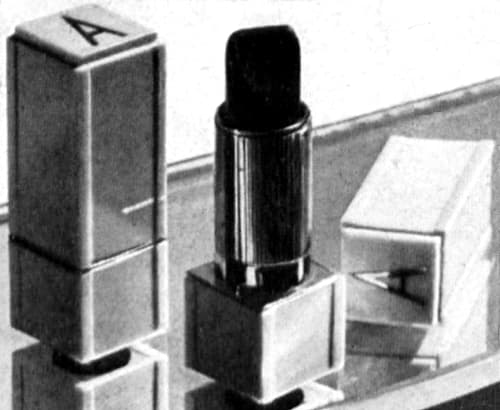
Above: 1938 Antoine Rouge à Lèvres (Lipsticks).
As well as lipsticks sold in standard and deluxe cases, Produits Antoine developed a two-tone lipstick, the first lipstick of this type that I know of. Available by 1930, it was known as Bi-Color in France and Lipstick Nuance in the United States. It had a shade for daytime use on one side of the stick and a second on the other side for use at night but the two colours could also be combined to contour the shape of the mouth. Bi-Color came in the same shades as the Antoine Deluxe Lipsticks which included Audaceiux, Deliceux, Profund, Bengali, and Mysterieux, the last shade being a changeable orange made along similar lines to the original Tangee.
Also see: Tangee
Other French Antoine lipstick shades from the 1930s included Fuschia, Font-Romeu, Tahiti, Ecarlate, Chamonix, Saint-Moritz, Vivant, Excitant, and Flamoyant. Special mention should be made of D’Or. Available by 1938 at the latest, the lipstick was the first that I know of to use gold as a lipstick colour. It could be used alone or applied over another shade to give the lips a metallic sheen.
Produits Antoine produced both cream and compact rouges with the later coming in a wider range of shades. Unfortunately, information on shade ranges is largely missing. The only 1930s tints that I know of were: Pharaon, Rose Mandarine, Rouge Orange, and Capucine.
Antoine lipsticks available in the United States during the 1930s appear to have been imported and used French names such as Audacieux, Exotique, Mysterieux and Profund. However, when cut off from the French company during the war it developed a number of new shades with distinctly American names such as Midnight Red, and Alerte (1940); Regimental (1941); Pink Riot (1944); Gay Gossip, and Highlight Red (1945); and Soleil (1946).
I can find little that is noteworthy for lipsticks and rouges produced in France after the war except that the iconic rectangular lipstick cases appear to have given way to more traditional tubular forms both there and in America. Known French shades available between 1945 and 1960 included; Oeillet, Aurore, Candeur, Lilas, Magique, Opéra, Rouge, Cerise, Bengali, Romantique, Tentation, Audacieux, Groseille, Bios de Rose, Mystérieux, Corail, and Gypsy. Shades were generally colour coordinated with Antoine rouges and/or Antoine nail lacquers.
Eye make-up
Produits Antoine eye make-up available in the 1930s included mascara, eyeshadow and eyebrow pencils. In France, the mascara was referred to as ‘Le Rimmel’ and, like its American counterpart, it came in Bleu (Blue), Vert (Green), Noir (Black), and Brun (Brown) shades. The eyebrow pencils were likely only available in Noir (Black) and Brun (Brown) but the range of eyeshadow shades was more extensive. The French shades included Gris Bleu, Bleu Lavande, Bleu Azur, Bleu Vert, Bleuté Ombré Bleu, Gris Léger, and Ocre Pâle with shades such as Bleu Argent, Blond Doré, Brun Doré, Gris Argent and Vert Argent recommended for evening use.
Eyeshadow shades available in France after the war included: Bleu Lavande, Bleu Argent, Ombré Bleu, Bris Bleu, Gris Léger, Vert Argent, and Chair Dorée. For eyelashes and there was Blue Vert, Bleu Fonce, Brun, and Noir, with Brun, and Noir for eyebrows.
False eyelashes were also available from Antoine before and after the war either as strips, which could be applied at home or in the salon, or singly, applied one at a time as extensions in a salon treatment.
See also: False Eyelashes
Hands and nails
In the early 1930s, Produits Antoine sold Lotion 880 for the hands along with a range of nail polishes it referred to as Nail Lacquers. The lacquers were available from Produits Antoine by 1930 at the latest but did not arrive in the United States until 1933. Lotion 880 was available in the United States as Antoine 880 in 1931.
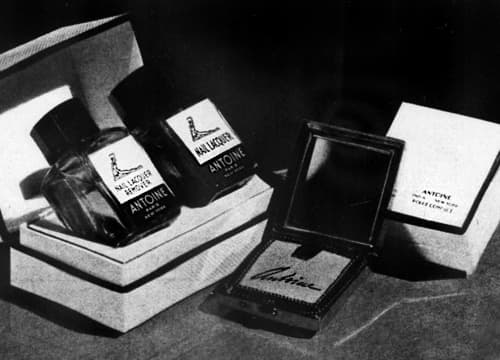
Above: 1933 Antoine Nail Lacquer and Remover in a boxed set (left) in shades that included Pomme Fleur, Corail, Rendre, Sophistiquer Chinois, Noir, and Verdure, and Rouge Compact with box (right) (United States).
In France, Produits Antoine was still selling transparent nail polishes (vernis transparents) as late as 1936 in shades that included Rose, Rubis, Laque, Capucine, Lumineux, Rouge, Coquelicot, Geranium, Cerise, and Framboise but also contained cream versions (laques lacquers) of the type that became predominant during the 1930s. Cream shades included colours such as Coquelicot, Cerise, and Framboise as well as mother-of-pearl shades which might reflect Antoine’s taste for shiny metallics.
See also: Nail Polishes/Enamels
French Nail Lacquer shades available after the war included: Oeillet, Aurore, Candeur, Lilas, Opéra, Magique, Groseille, Bengali, Bios de Rose, Corail, and Incolore, the last being transparent. Each shade was matched with a lipstick of the same name except for Incolore. Produits Antoine also sold Protecteur Antoine, a base coat, and Antoine 52, a nail polish remover.
Colour coordination
The Antoine make-up shade range was relatively limited. New colours were introduced intermittently but they were not heavily promoted like those produced by many American companies such as Revlon. Many make-up shades continued to be around for years. Pharaon, for example, introduced in the early 1930s, was still being included in Antoine colour ranges in the early 1960s.
The emphasis instead was to stress coordinated colour sets that aligned with current fashionable Paris colours. For example, when Antoine de Paris introduced the new purplish-plum Rue Cambon-Jour (day) and Rue Cambon-Soir (night) Lipsticks into the United States in 1938, each shade was coordinated with other Antoine make-up: Rue Cambon rouge for day and night; Peche Petal powder for day, Transparent for night; Mauve eyeshadow for day, Silver Mauve for night; and Purple Antoine mascara for both. Like Pharaon, Peche Petal, and Transparent powders had been available since the early 1930s.
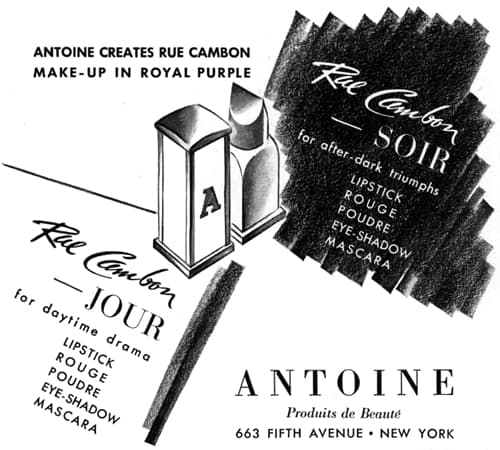
Above: 1938 Rue Cambon-Jour and Rue Cambon-Soir Lipsticks.
Coordinating make-up even extended to the beach. Bain de Soleil might be used to produce a tan but because this meant a woman had to alter her make-up to suit the darker skin tone, Antoine included a suitable foundation powder, lipstick and eyeshadow in the Antoine Beach Kit.
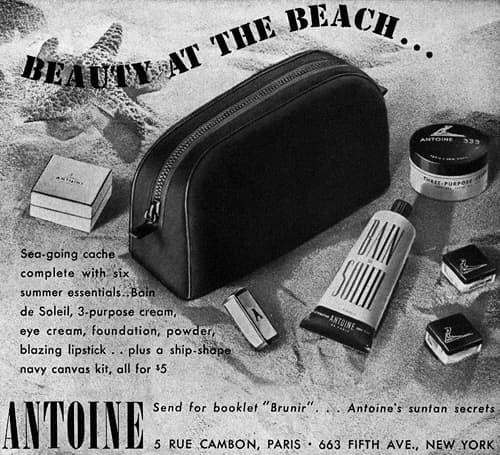
Above: 1940 Antoine Beach Kit. The bag was made from blue canvas with red piping and had a rubberised lining.
On some occasions shade selection was organised by hair colour. For example, when Produits Antoine introduced Maquillage à Danser in 1954, suggestions were made for blondes and brunettes. Shades for blondes were: Satin-Pêche: Hardi; Lipstick and Rouge: Candeur; Face Powder: Candeur; and Eye Shadow: Bleu-Lavande. For brunettes there was Satin-Pêche: Hardi; Lipstick and Rouge: Rose-Émoi; Face Powder: Ocre-Transparent; and Eye Shadow: Gris-Bleu.
Retirement
Antoine still held considerable standing after the Second World War but his stature rapidly declined as new, younger celebrity hairdressers became more influential, particularly with younger clients. Some, such as Alexandre de Paris, a.k.a Louis Alexandre Raimon [1922-2008], had been trained in Antoine salons. As Antoine’s standing diminished, interest in Antoine cosmetics declined.
By the 1960s, there were only three areas where Antoine cosmetics were selling in any appreciable numbers – Ban de Soleil and its flankers, Ski Cream, and a few hair lines such as Antoine Hair Fixative Cream in the United States.
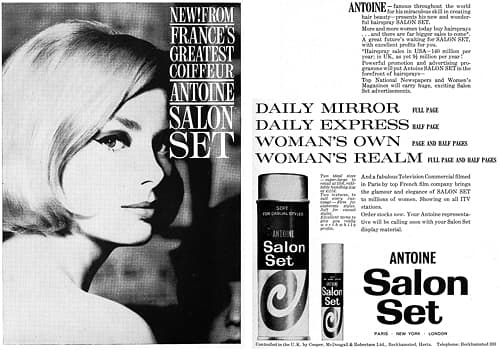
Above: 1962 Industry advertisement for Antoine Salon Set. The last big Antoine promotion in Britain.
After retiring from the industry, Antoine moved back to Sieradz where he remained until his death in 1975. Although he died in relative obscurity, his effect on the hairdressing industry can perhaps be best measured by the number of salons around the world that gave their business a French sounding name and staffed them with male hairdressers who, although not French, referred to themselves as Monsieur and spoke with a faux French accent.
Timeline
| 1912 | Salon opened at 5 Rue Cambon, Paris. |
| 1925 | Antoine de Paris Ltd. formed in London. London salon opened at 38 Dover Street, Mayfair. |
| 1927 | Seligman & Latz acquire the license to operate Antoine salons in the United States. Antoine de Paris salon opened in Saks Fifth Avenue. |
| n.d. | La Parfumerie de Gravigny founded. |
| 1928 | La Parfumerie de Gravigny opens offices in the Place de la Madeleine, Paris. |
| 1930 | Salon opened at Rond-Point d’Armenonville, Cannes. |
| 1931 | Antoine de Paris, Inc. established in New York. |
| 1933 | L’École Professionnelle Antoine opened in Paris. Some products repackaged. |
| 1935 | Antoine de Paris, Inc. (U.S.) sold by Hyman & Hyman to the American Safety Razor Co. |
| 1936 | Salon opened at 1 Place de la Bourse, Marseille. New Products (USA): Ski-Cream, and Ski Lipstick. |
| 1939 | Antoine de Paris, Inc. (U.S.) moves offices to 663 Fifth Avenue. |
| 1942 | New Products (USA): Stocking Stand-In. |
| 1955 | New Products (USA): For Gentlemen Cologne and After-Shave. |
| 1957 | Produits de Beauté Antoine S.A. established in Paris. |
| 1958 | Antoine de Paris (U.S.) sold to Lanvin Parfums. |
| 1959 | New Products (USA): Creme Vitonia; and Mistone Fluid Make-up. |
| 1961 | Mauvel Sales Company, Inc. buys the license to make and sell Antoine de Paris cosmetics in the United States. |
| 1963 | Antoine de Paris (U.S.) sold to Charles of the Ritz. |
| 1964 | Charles of the Ritz merges with Lanvin Parfums to form Lanvin-Charles of the Ritz, Inc. |
| 1971 | Lanvin-Charles of the Ritz sold to Squibb-Beechnut. |
| 1986 | Lanvin-Charles of the Ritz, Inc. acquired by Yves Saint Laurent. |
| 1987 | Most of Lanvin-Charles of the Ritz sold to Revlon which then sells Bain de Soleil to Procter & Gamble. |
| 1991 | Produits de Beauté Antoine S.A. disbanded. |
| 1995 | Bain de Soleil sold to Pfizer. |
| 1999 | Bain de Soleil bought by Schering-Plough. |
First Posted: 9th March 2022
Last Update: 13th July 2022
Sources
The American Perfumer & Essential Oil Review. (1906-1955). New York: Robbins Perfumer Co. [etc.].
Antoine. (1946). Antoine. London: W. H. Allen & Co. Ltd.
Antoine de Paris, Inc. (1932) Antoine de Paris his method [Booklet]. New York: Author.
Charensol. (1925). L’art du maquillage. L’Art Vivant, January, 1(1), 33.
Conseils d’Antoine. (c.1950). [Booklet]. Paris.
Fernandez, J. (1932). Un interview de Madame Antoine. Antoine Document, July-August, No 2, 12-13.
U. S. Hairdressing (1934). Fortune. September 10(3), 83-87, 178.
Wist, R. (1992). On Fifth Avenue: Then and now. Secaucus, N.J.: Carol Publishing Group.
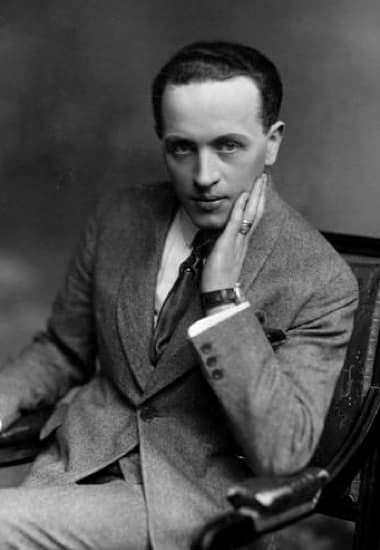
Antoni Cierplikowski, Jr. [1884-1976], a.k.a. Antoine Cierplikowski, and Antoine de Paris.
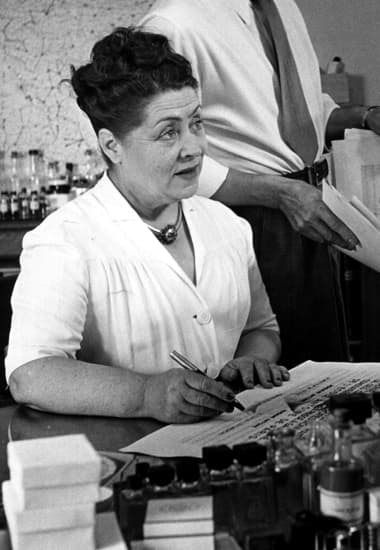
Marie Louise Berthe Cierplikowski née Astier [1887-1972], Antoine’s wife and business manager.
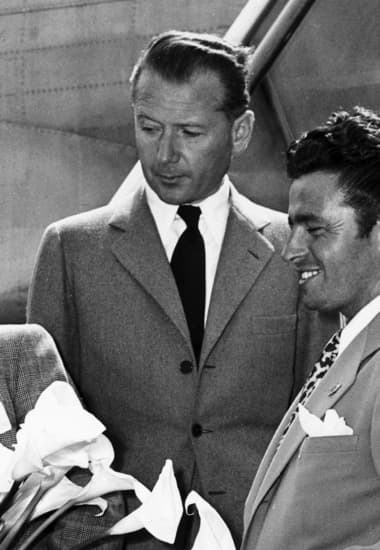
Benoit Jean Millien [1900-1990] standing in front of a plane Benoit used to pilot Antoine around Europe.
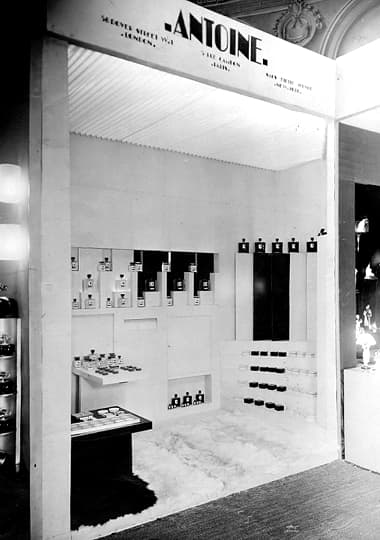
1927 Antoine stand at the 3rd Exposition Française des Arts de la Coiffure et de la Parfumerie, Paris. There don't appear to be any lipsticks on display.
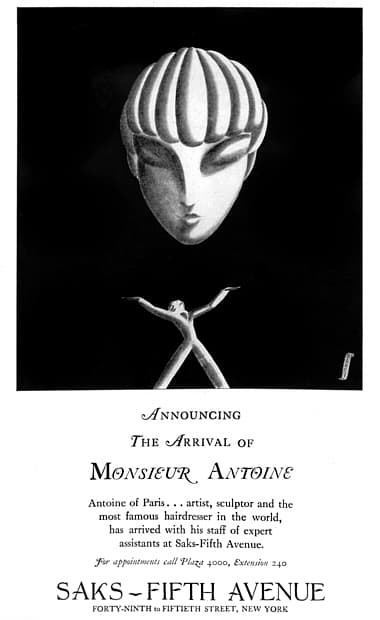
1927 Announcement of Antoine’s arrival at Saks Fifth Avenue, New York.
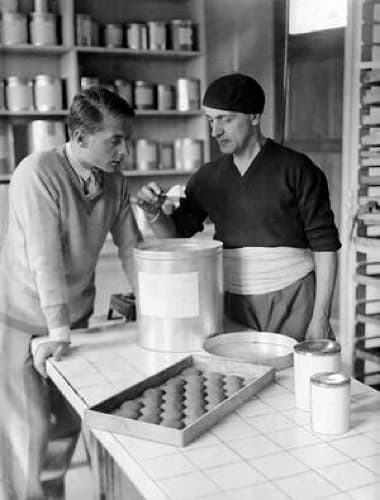
1929 Benoit and Antoine in what looks to be the Parfumerie de Gravigny.
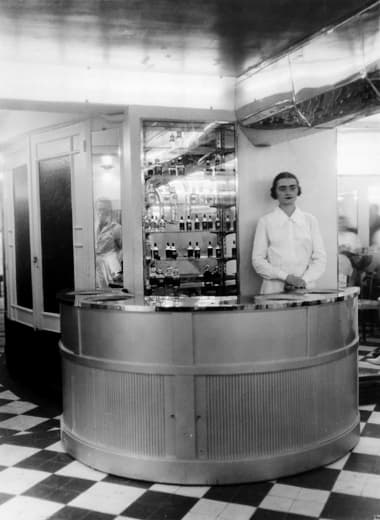
c.1930 Reception in the Paris salon.
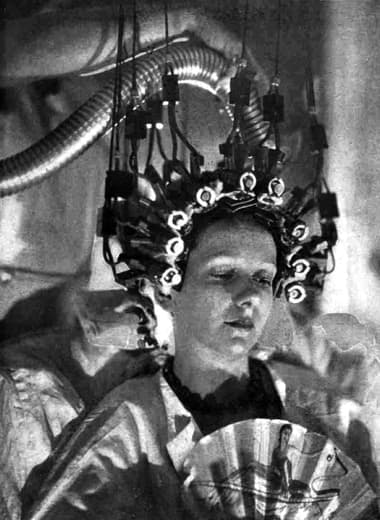
1930 Woman having a permanent wave in the Antoine salon at 5 Rue Cambon using a fan to keep cool.
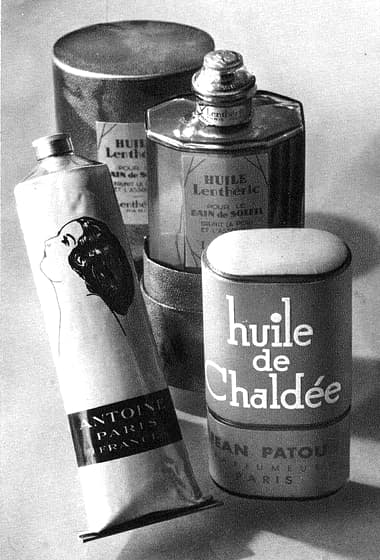
1931 Antoine Bain de Soleil (left) in what looks to be original packaging. The product was sold in a tube as this was considered to be more convenient..
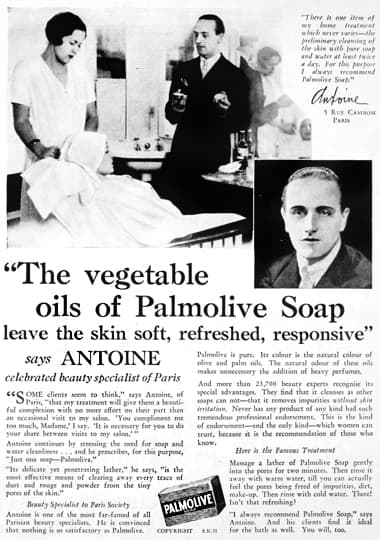
1931 Product placement for Palmolive Soap.
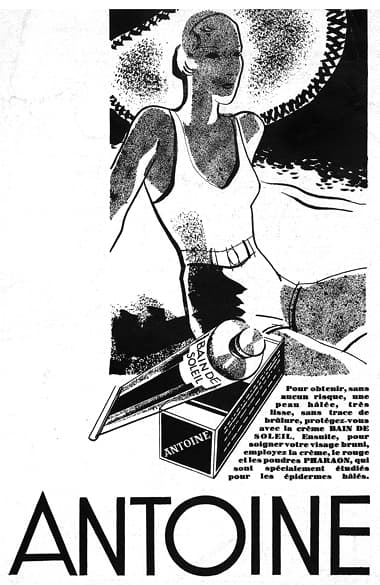
1932 Antoine Bain de Soleil.
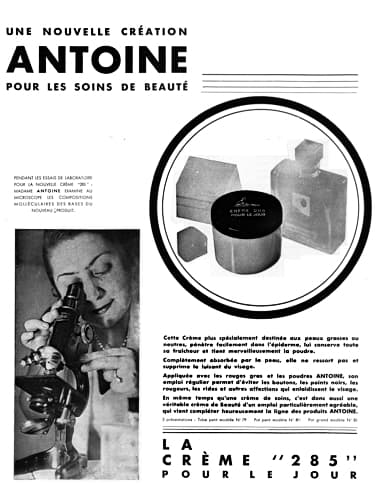
1932 Antoine Crème 285.
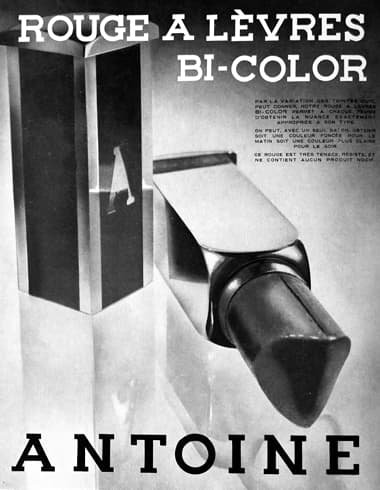
1933 Antoine Bi-Color Lipstick.
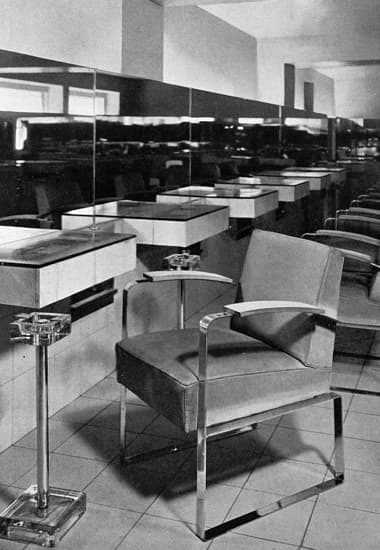
1933 Interior of Antoine salon in the Rue Cambon.
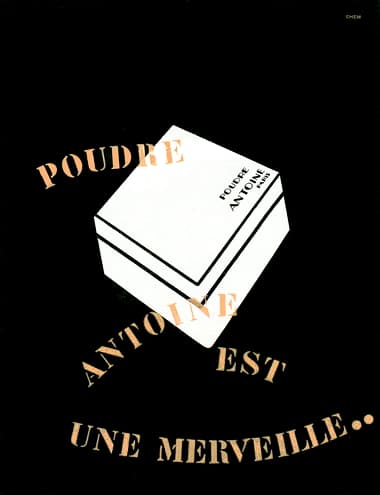
1933 Poudre Antoine.
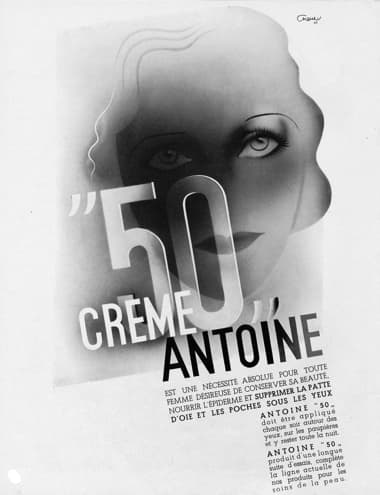
1933 Antoine Crème 50.
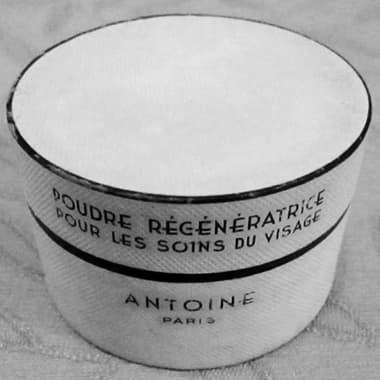
Poudre Régénératrice.
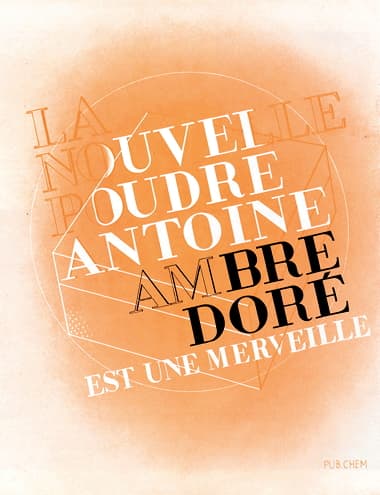
1933 Antoine Ambre Doré Powder.
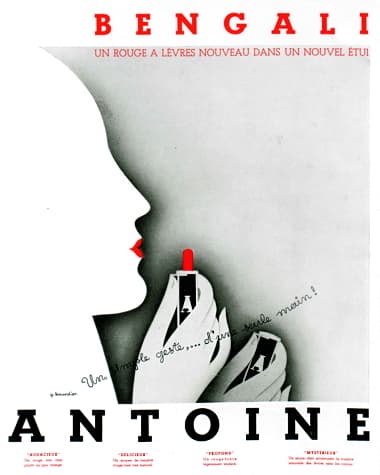
1934 Antoine Bengali Lipstick.
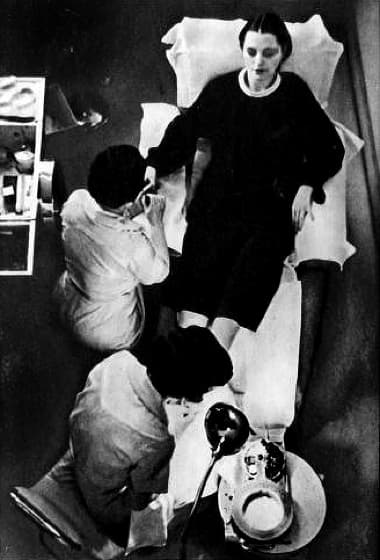
1934 Woman having a manicure and pedicure at the Antoine salon in Saks Fifth Avenue.
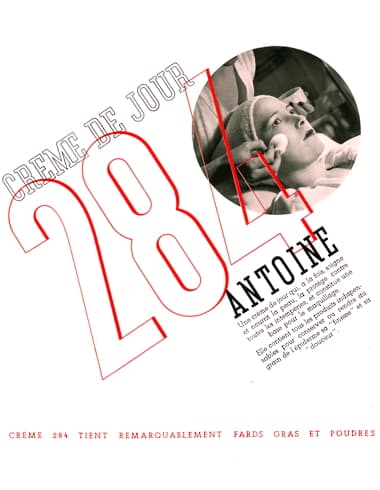
1934 Antoine Creme de Jour 284.
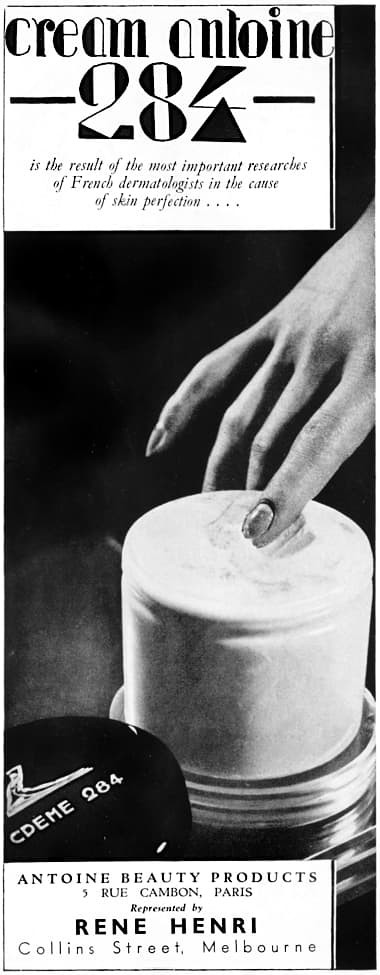
1935 Creme Antoine 284 (Australia).
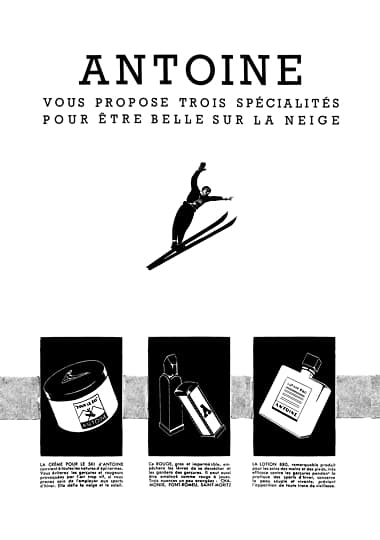
1936 Antoine Crème Pour le Ski, Chamonix, Font-Romeu, and Saint-Moritz Lipsticks, and Lotion 880.
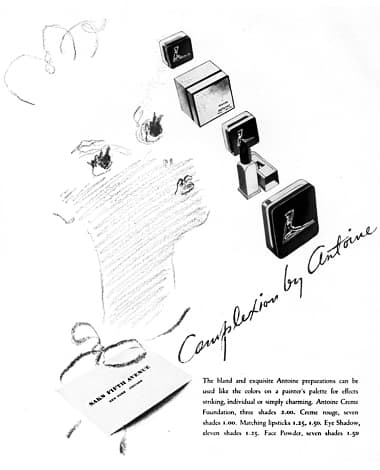
1936 Antoine at Saks (USA).
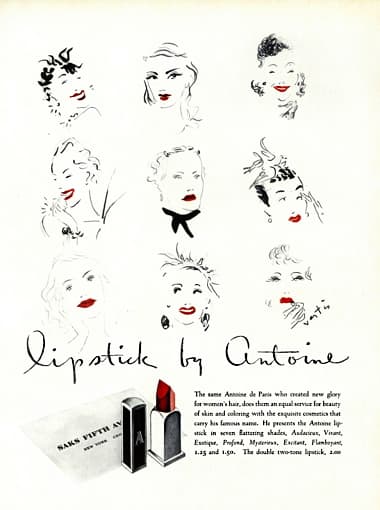
1936 Antoine Lipsticks (United States).
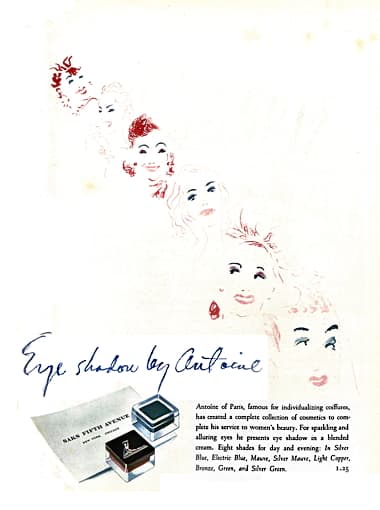
1936 Antoine Eye shadows (USA).
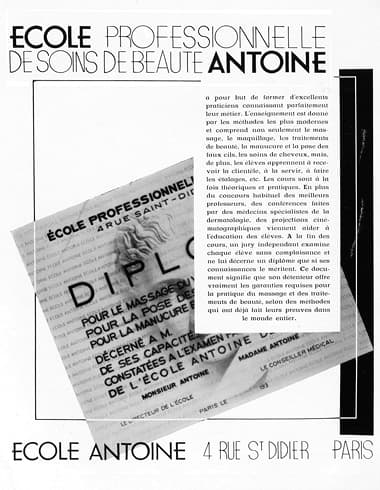
1937 Ecole Professional Antoine.
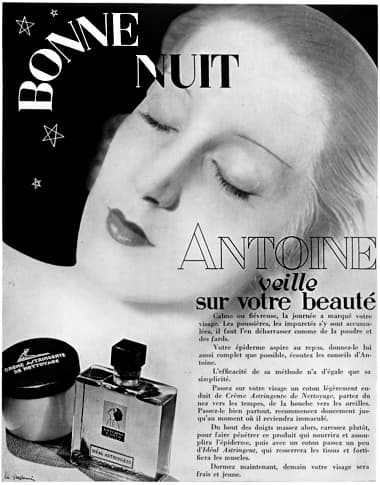
1937 Antoine Crème Astringent de Nettoyage and Ideal Astringent.
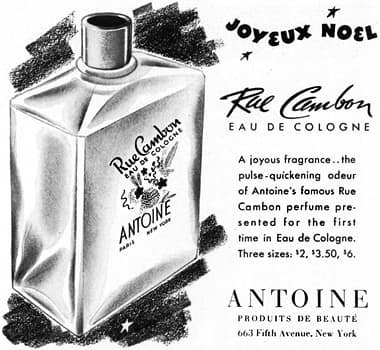
1938 Antoine Rue Cambon Cologne (USA).

1938 Antoine Crème 333, 284 and 285.
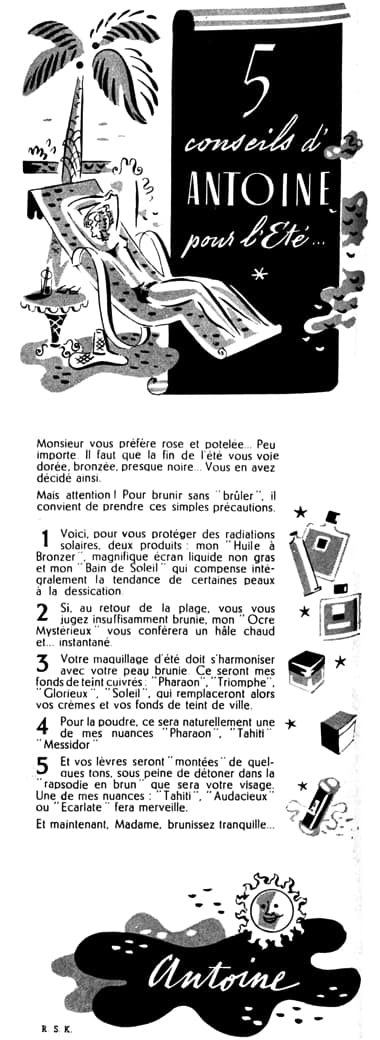
1938 Antoine cosmetics for the summer sun.
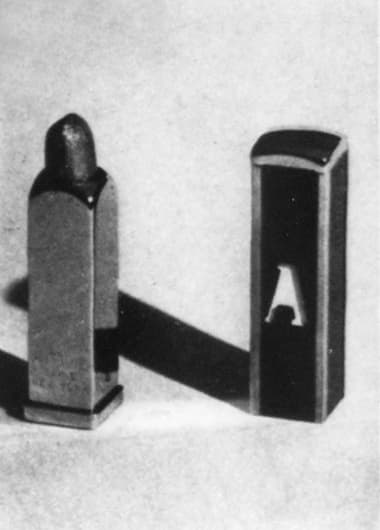
1938 Antoine Lipstick D’Or (USA).
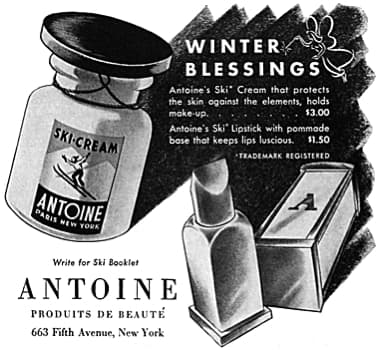
1939 Antoine Ski Cream and Ski Lipstick (USA).
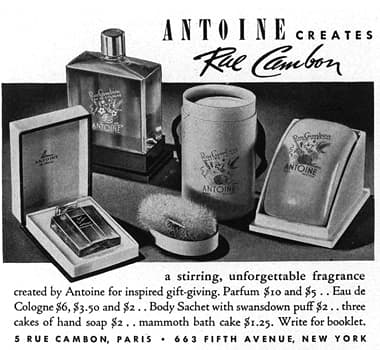
1939 Antoine Rue Cambon Parfum, Eu de Cologne, Body Sachet with Puff, and Bath Soap (USA).
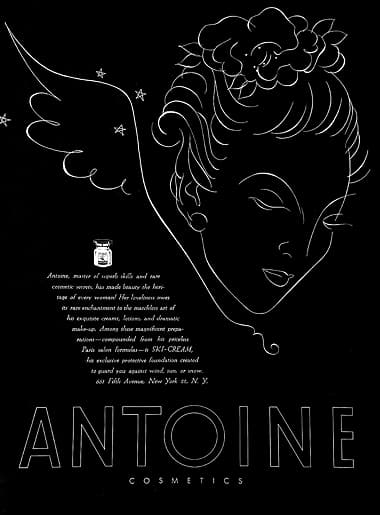
1943 Antoine Ski Cream (USA).
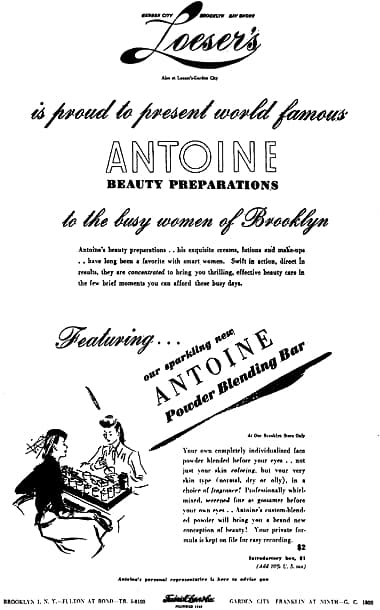
1943 Antoine powder blending service (USA).
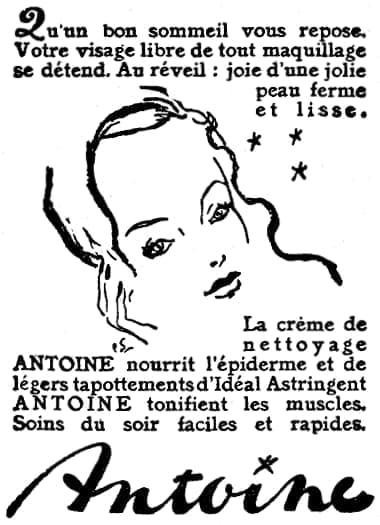
1944 Crème de Nettoyage and Idéal Astringent.
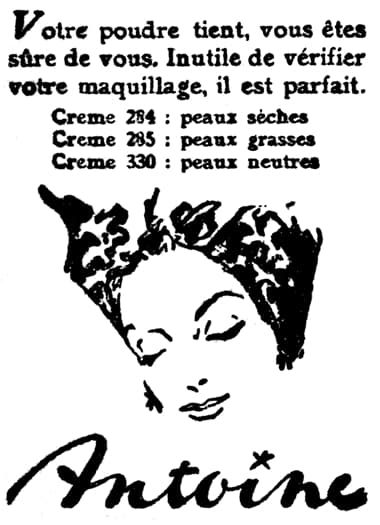
1944 Antoine Crèmes 284, 285, and 330.
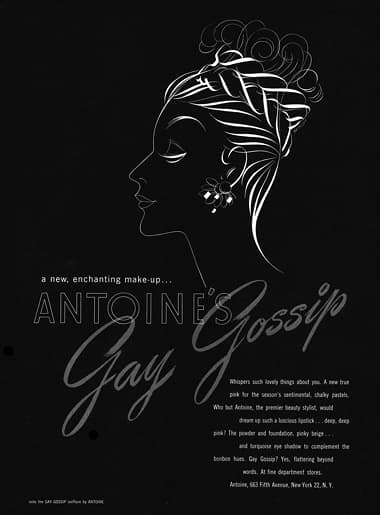
1945 Antoine Gay Gossip (USA).
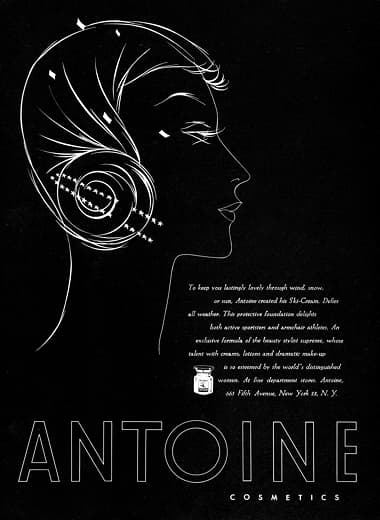
1945 Antoine Ski Cream (USA).
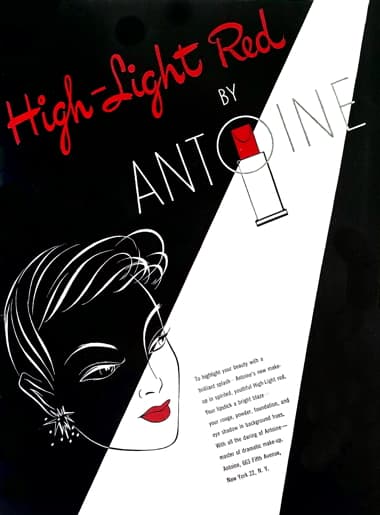
1945 Antoine Highlight Red (USA).
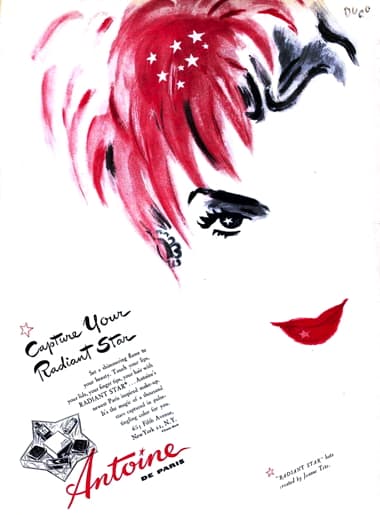
1946 Antoine Radiant Star (USA).
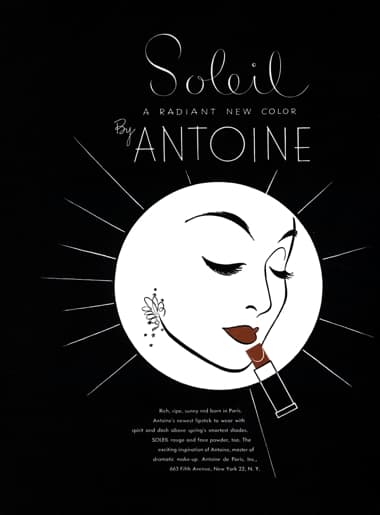
1946 Antoine Soleil (USA).
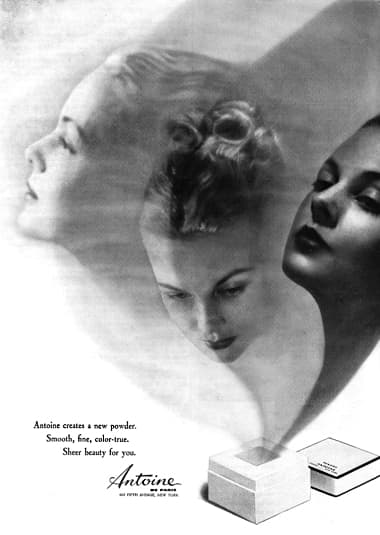
1947 Antoine Face Powder (USA)
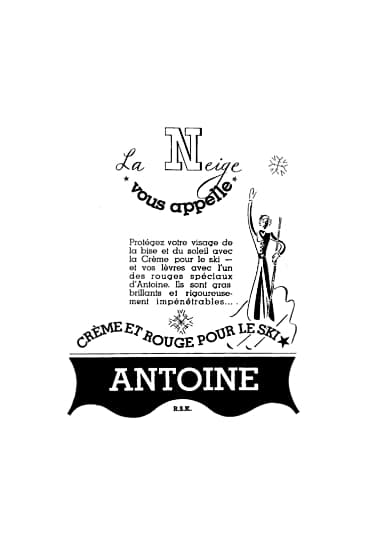
1947 Antoine crème et rouge pour le ski.
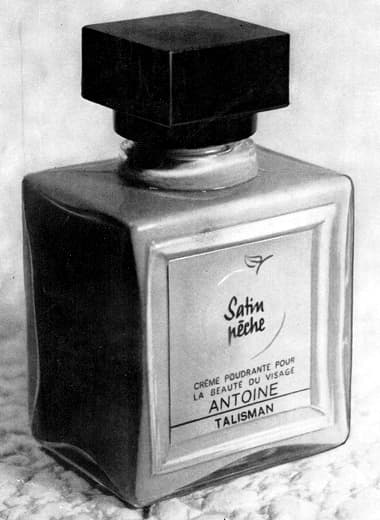
Antoine Satin Pêche.
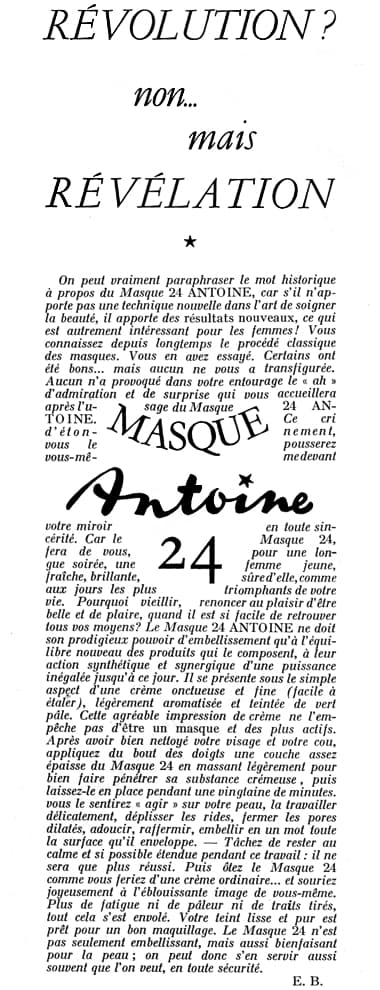
1949 Antoine Masque 24.
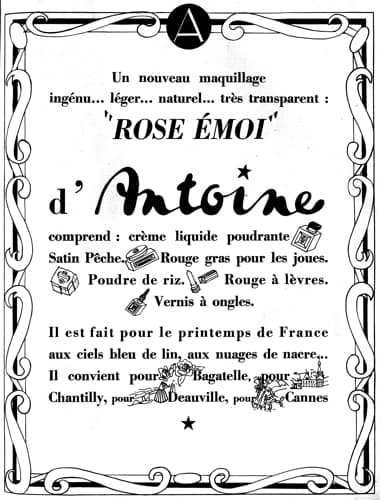
1952 Antoine Rose Émoi.
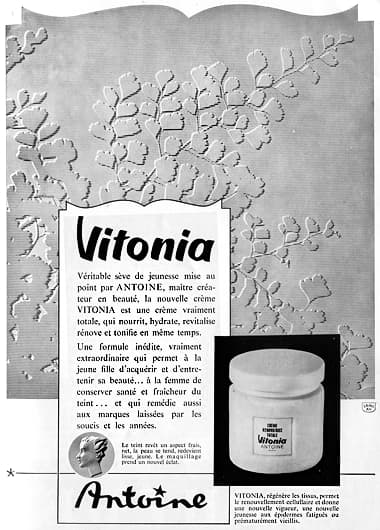
1956 Antoine Crème Vitonia.
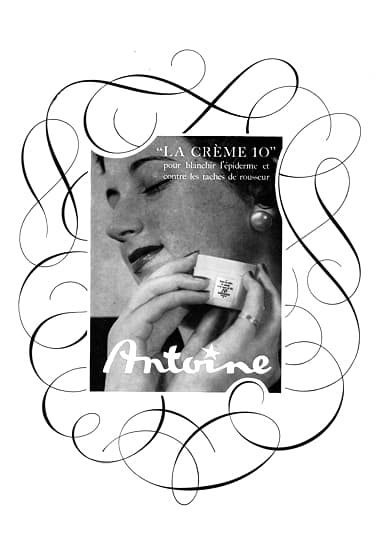
1956 Antoine Crème 10.
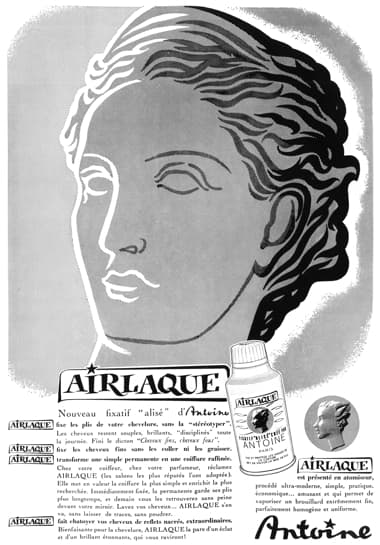
1956 Antoine Airlaque.
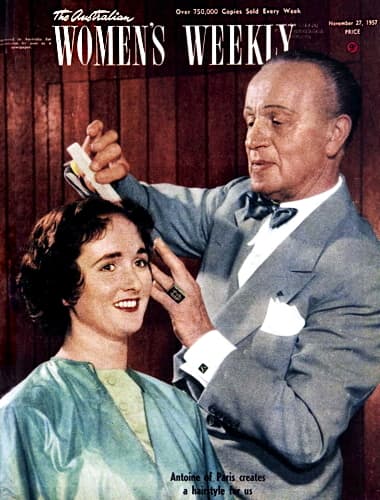
1957 Antoine on the cover of The Australian Women’s Weekly taken during his visit.
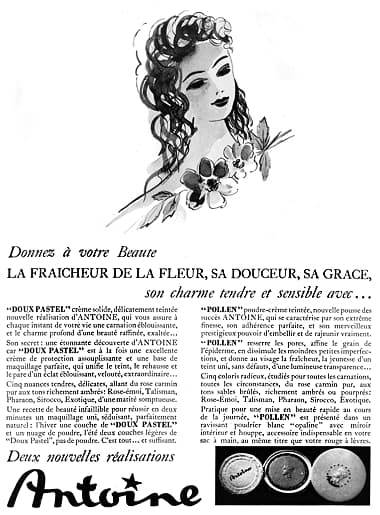
1957 Antoine Deux Pastel and Pollen Make-up.
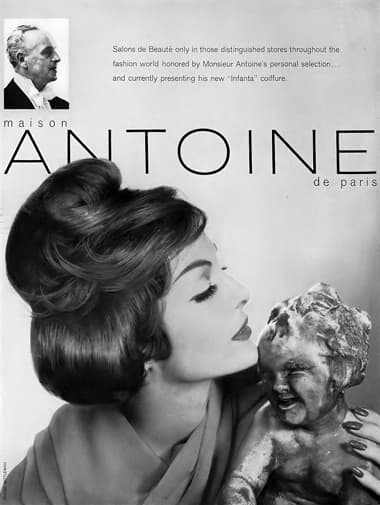
1958 Maison Antoine (USA).
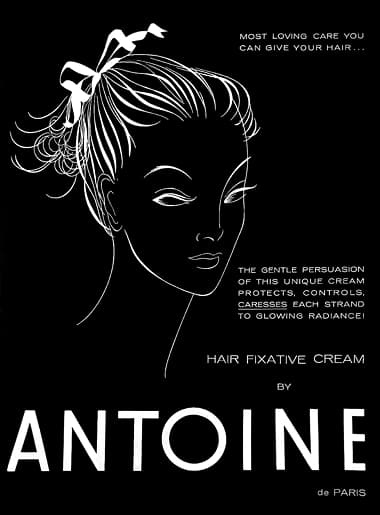
1958 Antoine Hair Fixative Cream (USA).
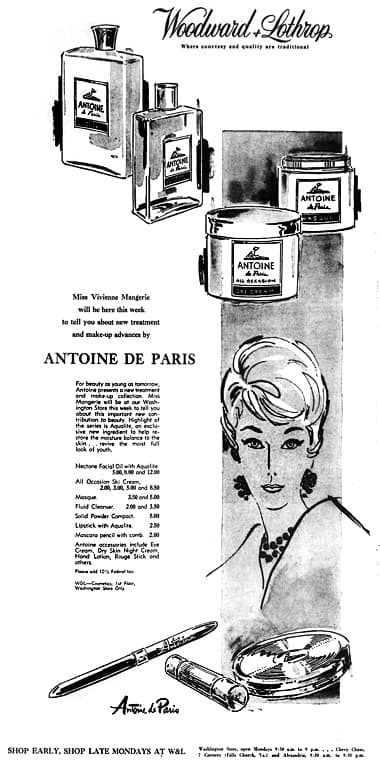
1959 Antoine de Paris (USA).
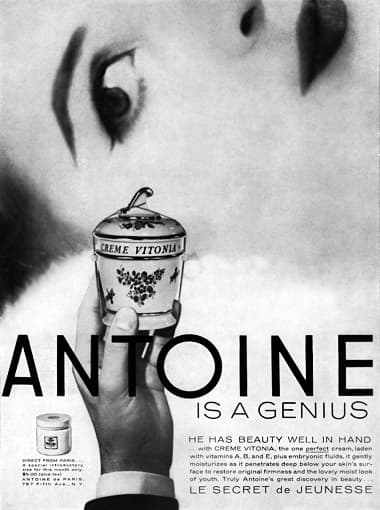
1960 Antoine Creme Vitonia (USA).
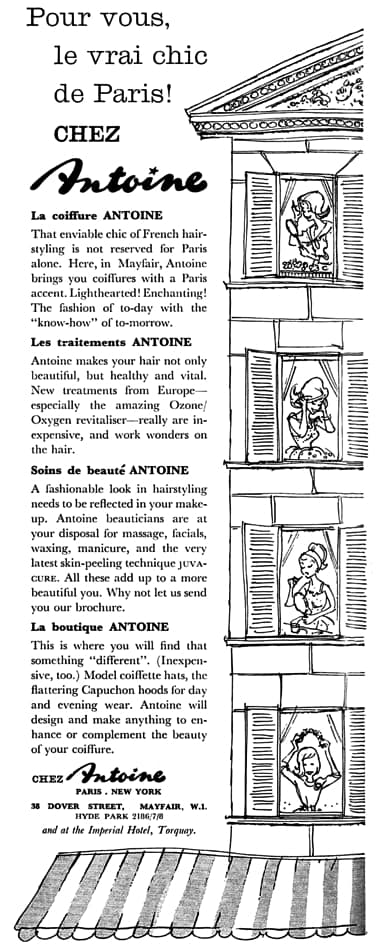
1961 Antoine Dover Street (UK).
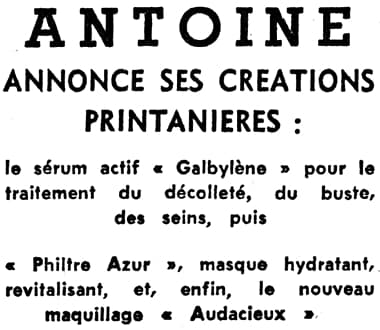
1963 Antoine Galbylène and Philtre Azur.
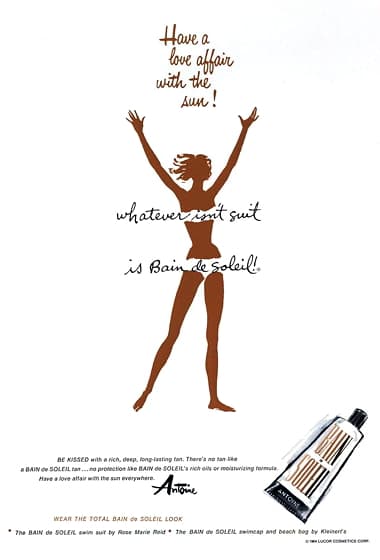
1964 Antoine Ban de Soleil (USA).
